Preservation can promote equity for Black communities, report says
Preservation should be community-driven and focused on people, according to the report, but too often it is dictated by outside forces and is “building-centered.”

The Kensington Corridor Trust formed in 2019 to invest in the Kensington Avenue commercial corridor, transition properties to neighborhood control, and protect residents and businesses in the neighborhood from being displaced. It lists equity as one of its guiding values.
The National Trust for Historic Preservation is citing the organization as an example of how communities can use land trusts to ensure they stay affordable. Preservation can be a tool to stabilize neighborhoods and to foster equitable growth in Black and other marginalized communities, the National Trust has found. Philadelphia was one of 10 cities nationwide that the National Trust explored in an October report.
“A lot more work needs to be done to establish trust and empower communities to leverage what preservation has to offer as a tool,” said Di Gao, senior director of research and development at the National Trust, at a virtual panel about the report Wednesday. “The drivers of displacement and the roots of place-based inequity are systemic and based on factors that stretch far beyond the traditional scope of preservation alone.”
Nationwide, historically Black neighborhoods see higher rates of demolition, undervalued housing, underfunded essential services, and reduced access to financing than in other areas, according to the National Trust’s report. In Philadelphia, only about 6% of historically designated properties are in historically Black census tracts, according to the report’s researchers.
“The places that tell the story of resilience in [Black and other historically marginalized] communities have been systematically undervalued, underinvested, demolished, and erased from our physical landscape for far too long,” the report’s authors wrote. Preservationists must “contend with and unpack how the traditional methods and standards of preserving buildings may be perpetuating systems of injustice.”
In years past, preservation has not demonstrated its relevance to marginalized communities, so it must shed its elitist perception and adapt to meet the needs of a broader section of Americans, Gao said.
Preserving and investing in the maintenance of older properties can help prevent the displacement of longtime residents. Patrick Grossi, director of advocacy at the Preservation Alliance for Greater Philadelphia, which convened Wednesday’s panel, said one of the most common calls the organization gets is from owners of older homes who need help with maintenance. Even with Philadelphia’s large stock of old housing presenting a large demand, few programs meet these owners’ needs, he said.
» READ MORE: Developer’s condos would destroy South Philly’s famed Black ‘Doctors’ Row’ | Inga Saffron
Preservation should be community-driven and focused on people, according to the report, but too often it is dictated by outside forces and is “building-centered.” Preservation also is impeded by unequal decisions about what is considered historic or culturally significant in Black neighborhoods compared with other neighborhoods and by city policies that allow historic buildings that could be restored and adapted for community use to be demolished. Black communities often also have less access to the money and other resources needed for revitalization and for the pursuit of historic designations.
“More emphasis needs to be placed on culture, heritage, and legacy rather than focusing almost exclusively on the integrity of physical buildings,” Gao said.
To promote equity in preservation and community development, residents must be able to make decisions about their own neighborhoods, the report said. Preservation-related professionals must be racially diverse. Preservation efforts in historically Black neighborhoods must invest in Black cultural sites. Community revitalization must address systemic inequalities, a goal some cities are tackling by funding the adaptation of vacant properties into community spaces and promoting community ownership.
» READ MORE: Philly’s Dox Thrash house will get a second life with preservationists acting as investor-partners
Some communities oppose historic designation because they see preservation as a burden on residents and businesses and as an agent of gentrification, Gao said. City policies can help correct these criticisms.
Preservationists must use high-quality data to demonstrate the need for policies that support equitable development, measure how their work affects communities in the long term, form partnerships in the public and private sectors to pool resources, and evaluate neighborhood development in the context of the wider geographical regions, the report said.
“The time is now for our nation to examine and reduce place-based inequities and to pursue ideas yet to be seen that scale up and fast-track the preservation of and investment in African American landmarks and neighborhoods,” Brent Leggs, executive director of the National Trust’s African American Cultural Heritage Action Fund, wrote in the report.